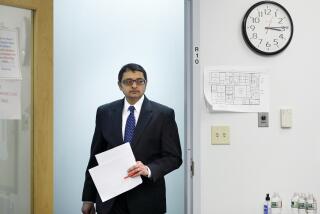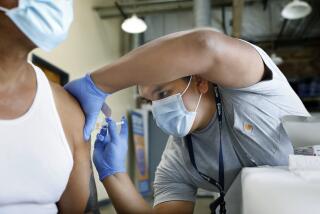U.S. Targets 30 Areas for AIDS Surveys
- Share via
The federal Centers for Disease Control, after months of internal debate, is quietly mobilizing an ambitious plan to accurately determine the number of Americans infected with the AIDS virus, The Times has learned.
The nationwide project will target 20 AIDS high-risk metropolitan areas, including Los Angeles, San Francisco and New York City, and 10 low-risk areas for an intensive series of coordinated epidemiological surveys, set to begin before the end of the year.
The surveys are designed to improve upon the current imprecise estimate that between 1 million and 2 million Americans are infected with the AIDS virus, and to shed further light on such controversial questions as the risk of AIDS virus infection in the nation’s heterosexual population.
Blood samples will be collected at sites ranging from sexually transmitted disease clinics and drug treatment centers to hospitals, colleges and prisons.
CDC director Dr. James O. Mason announced the new strategy in a conference telephone call Sept. 25 with state health officials and representatives of the designated metropolitan areas. Public announcement is being withheld until after planning meetings are held in Atlanta next week.
The go-ahead for the high-priority effort comes at a time when one of the federal government’s own studies is raising serious questions about the validity of the previously announced plan to determine the number of infected Americans--by using blood samples collected at random as part of a national house-to-house survey.
That survey of 45,000 Americans, which would cost millions of dollars, was announced with much fanfare at the International AIDS Conference in Washington in June.
Many Would Refuse
But an ongoing in-person poll by the National Center for Health Statistics is showing that many adults would refuse to participate in such a survey, even if they received guarantees of the confidentiality of the results.
Between mid-August and early September, about 4,000 participants in the “National Health Interview Survey” were asked: “If you were selected in this national sample of people to have their blood tested with assurances of privacy of test results, would you have the test?”
About two-thirds of the respondents said “yes” and one-third said “no,” according to Ronald W. Wilson, the director of the center’s division of epidemiology and health promotion.
Such a low rate of participation could invalidate the results of a random national survey because less than 1% of the general population is believed to be infected with the AIDS virus.
Moreover, some public health officials fear that people who know they are infected with the acquired immune deficiency syndrome virus or believe they are at high risk to test positive might be even less willing to participate. This could further skew the results.
As a result of such data, CDC officials believe that a small pilot study is necessary to see if it makes sense to go forward with the survey of the 45,000 Americans.
But even a pilot study is unlikely to begin until next year, in part because the CDC has yet to decide if it will perform the study itself or contract the work out to a private organization.
Calls It Difficult
“This is a very difficult survey to do,” said Dr. Walter R. Dowdle, the deputy CDC director who oversees the center’s AIDS programs. “If you undertake something like this, you want to do it right.”
In a telephone interview, Dowdle confirmed that the series of “sentinel” AIDS surveys in urban areas is now the center’s “main effort” to obtain data on the number and distribution of Americans infected with the human immuno-deficiency virus. The vast majority of the 42,354 AIDS cases and 24,412 AIDS deaths reported through the end of September have been clustered in cities and suburbs.
“We are all quite frankly very excited about this,” Dowdle said. “We are working with the states and cities to have a consistent sampling over time in which we would expect the individuals at highest risk (of AIDS virus infection) to participate. We will get information on what the sero-prevalence (rate of AIDS virus infection) is now and how it changes over time.”
But Dowdle and other officials of the federal agency declined to provide details of the sampling protocols in advance of the Oct. 14-16 planning meetings, at which time such issues as the criteria for recruiting participants and the confidentiality of test results are to be discussed.
Preparatory Work
To coordinate the surveys, the CDC is installing telephones and computers in an auditorium at its Atlanta headquarters and assigning dozens of physicians and other staff to the project.
CDC epidemiologists will begin work in the designated metropolitan areas before the end of October. By the end of November, the first progress report is to be prepared for the White House Domestic Policy Council.
In many cases, the project will build upon local and state AIDS monitoring activities that are already under way. Among the other metropolitan areas to be studied are Cleveland, Honolulu, Phoenix, Richmond, St. Louis and Seattle.
The testing sites under consideration include medical clinics, such as those treating sexually transmitted disease, tuberculosis or family planning patients and so-called “sentinel” hospitals where anonymous AIDS antibodies blood tests are already being performed on random blood samples from patients with non-AIDS illnesses.
Blood samples are also to be collected at drug treatment centers, some state and federal prisons and at a small number of colleges.
More to Read
Sign up for Essential California
The most important California stories and recommendations in your inbox every morning.
You may occasionally receive promotional content from the Los Angeles Times.













